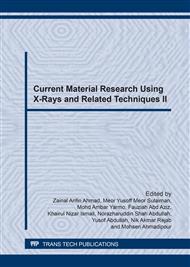p.3
p.7
p.12
p.17
p.23
p.28
p.33
p.37
Characterization of 3 mol% Fe from Different Source Doped 8YSZ Ceramics
Abstract:
Pure 8 mol% yttria stabilized zirconia (YSZ) and 3mol % of Fe-doped YSZ electrolyte from different source of Fe (p)in oxide form (pure iron oxide powders, Fe2O3) and Fe(s) source from salt (iron nitrate, Fe(NO3)3) were prepared and sintered at 1550°C for 2 hours. The effect of Fe dopant from different source of Fe to the crystal structure and ionic conductivity of 8YSZ samples were investigated. The addition of 3 mol % Fe from iron nitrate source (sample 3Fe(s)YSZ) greatly enhanced the growth of monoclinic phase as compared to 8YSZ sintered samples while the addition of 3 mol % Fe from pure iron oxide powder source (sample 3Fe(s)YSZ) enhanced the crystallization of cubic phase and decrease the monoclinic phase. The addition of Fe significantly enhanced the ionic conductivity of 8YSZ sample for both source of Fe. However, 3Fe(p)8YSZ has smaller grain resistivity and thus has higher conductivity compared to 3Fe(s)YSZ.
Info:
Periodical:
Pages:
3-6
Citation:
Online since:
March 2017
Authors:
Keywords:
Price:
Сopyright:
© 2017 Trans Tech Publications Ltd. All Rights Reserved
Share:
Citation:


